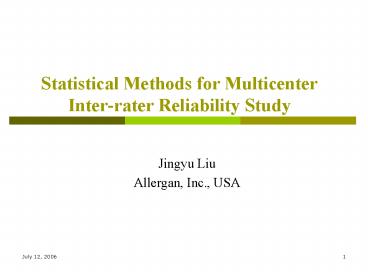Statistical Methods for Multicenter Interrater Reliability Study - PowerPoint PPT Presentation
1 / 15
Title:
Statistical Methods for Multicenter Interrater Reliability Study
Description:
Can BOTOX improve arm or hand function of a post stroke spasticity ... Thanks to Allergan Biostatistics and BOTOX-Neurology for the supports on this research. ... – PowerPoint PPT presentation
Number of Views:415
Avg rating:5.0/5.0
Title: Statistical Methods for Multicenter Interrater Reliability Study
1
Statistical Methods for Multicenter Inter-rater
Reliability Study
- Jingyu Liu
- Allergan, Inc., USA
2
Overview
- Introduction
- Multicenter inter-rater reliability
- Statistical methods
- References
- Acknowledgement
3
Introduction
- Can BOTOX improve arm or hand function of a post
stroke spasticity patient?
4
Function Assessments and Validation
- Identify function items
- Identify the measurement scale
- Are the function assessments reliable, sensitive,
and clinically meaningful? - What is the minimum important change (MIC) of the
assessment? - Assessment (scale) validation reliability and
validity - Inter-rater reliability
- One of the key steps in clinical outcome
assessment scale validation.
5
Multicenter inter-rater reliability
- Inter-rater reliability study
- In a clinical setting, an inter-rater
reliability study is to evaluate the agreement
among different raters (or physicians) by using
the same assessment scale on each of the subjects
(or patients) enrolled in the study. - Multicenter inter-rater reliability study
- It is an inter-rater reliability study conducted
in multiple clinical study centers (or sites). - Why conduct multicenter inter-rater reliability
study? - It is difficult to conduct a large inter-rater
reliability study in a single clinical study
center. - It is closer to an actual multicenter clinical
study setting (preferred by some regulatory
agency).
6
Statistical Methods
- Will focus on the following
- Inter-class correlation coefficient (ICC) based
on the ANOVA method under a random effect model - Introduce a new approach to evaluate the
inter-rater reliability - Nonparametric methods
- Discuss the other methods
7
Statistical Methods
- Assessments at the i-th study center (i1,
2, ,a)
8
Statistical Methods
- ANOVA method to evaluate the inter-rater
reliability by an inter-class correlation
coefficient (ICC) under a random effect model - Statistical inference on is
straightforward.
9
Statistical Methods
- The ICC is the Pearson correlation
coefficient of the assessments made by two raters
on a same subject, i.e.
-
where - The Pearson correlation coefficient measures a
linear relationship of two variables. It does not
necessarily measure the absolute agreement. - As noted by Lin 1 in a special case of two
raters (or two assays), a good agreement between
the two raters requires that the plot of the
assessments of the two raters falls closely on a
line through the origin. - The ICC is influenced by the subject variation.
In an inter-rater reliability study, the subject
variation itself is not of interest and the
subjects are usually not randomly selected.
10
Statistical Methods
- For an interval variable with a domain a, b,
Liu 2 introduce a new agreement coefficient to
evaluate the inter-rater reliability as follows -
or - where is the theoretical range of the
variable (i.e., b a), is the
measurement variance of the raters, and is
a pre-defined reliability scale parameter. - is invariant under a linear transformation.
With this property we can compare the
reliabilities of the outcome assessment scales
under different domains. - Most clinical outcome assessments are either
interval variable or ordinal numerical variable.
is applicable to these variables.
11
Statistical Methods
- For a multicenter inter-rater reliability
study, can be estimated by - where and
- When there are only two raters within each
center, we have
12
Statistical Methods
- Statistical inferences such as hypothesis test,
confidence interval, and power calculation are
obtained based on the results provided in Liu
2. - As a special case of two raters, the can be
applied in evaluating the test-retest reliability
or the intra-rater reliability. - In clinical research, we select in
calculating - can be applied in more complicated
situations such as imbalanced data as well as
data with missing values.
13
Statistical Methods
- Nonparametric approaches
- When the distribution assumption or the model
assumption is not appropriate, we can use the
nonparametric approach to evaluating the
inter-rater reliability. - For a single center study, we can directly use
Kendalls W - For a multicenter study, Liu3 introduced a new
statistic which can be considered as an extension
of Kendalls W to evaluate the inter-rater
reliability. The distribution property,
hypothesis test, confidence interval, etc. are
provided. - Other weighted approaches
- Other Statistical methods
14
References
- Lin LI. A concordance correlation coefficient to
evaluate reproducibility. Biometrics 1989 45,
255-268. - Liu J. Measures of inter-rater reliability for
interval data. (submitted for publication). - Liu J. A nonparametric approach to evaluating
multicenter inter-rater reliability. (submitted
for publication). - Shoukri M. Measures of Interobserver Agreement.
Chapman Hall/CRC. 2004 - Fleiss JL. The Design and Analysis of Clinical
Experiments. John Wiley Sons. 1986. - Schuck P. Assessing reproducibility for interval
data in health-related quality of life
questionnaires Which coefficient should be used?
Quality of Life Research 2004 13, 571-586. - Searle SR. Linear Model. John Wiley Sons. 1971.
- Kendall MG. A new measure of rank correlation.
Biometrika 1938 3081-93. - Mehta C, Patel N, Proc-StatXact 4, CYTEL Software
Corporation, 1999. - Friedman M. The use of ranks to avoid the
assumption of normality implicit in the analysis
of variance. Journal of American Statistical
Association, 1937 32675-701.
15
Acknowledgement
- Thanks to Allergan Biostatistics and
BOTOX-Neurology for the supports on this
research. I also wish to thank the supports from
the sponsors of the 2006 International Conference
on Design of Experiments and Its Application.































